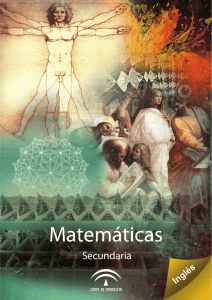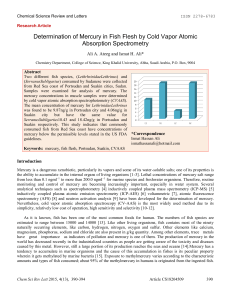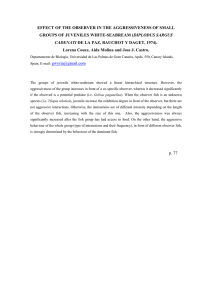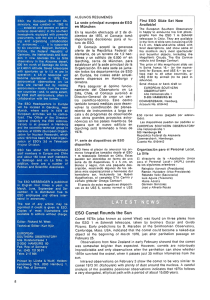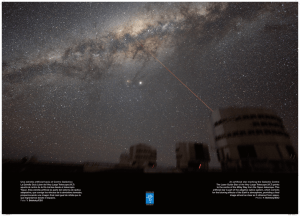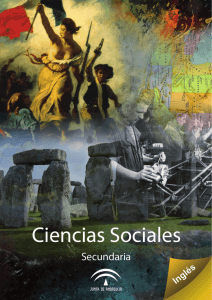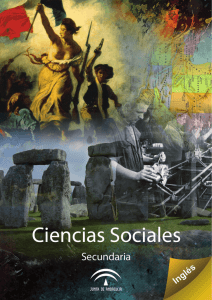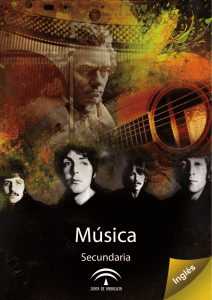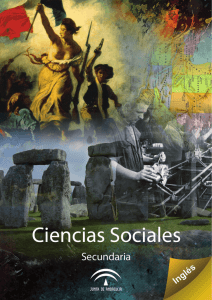How science works (solucionario)
Anuncio
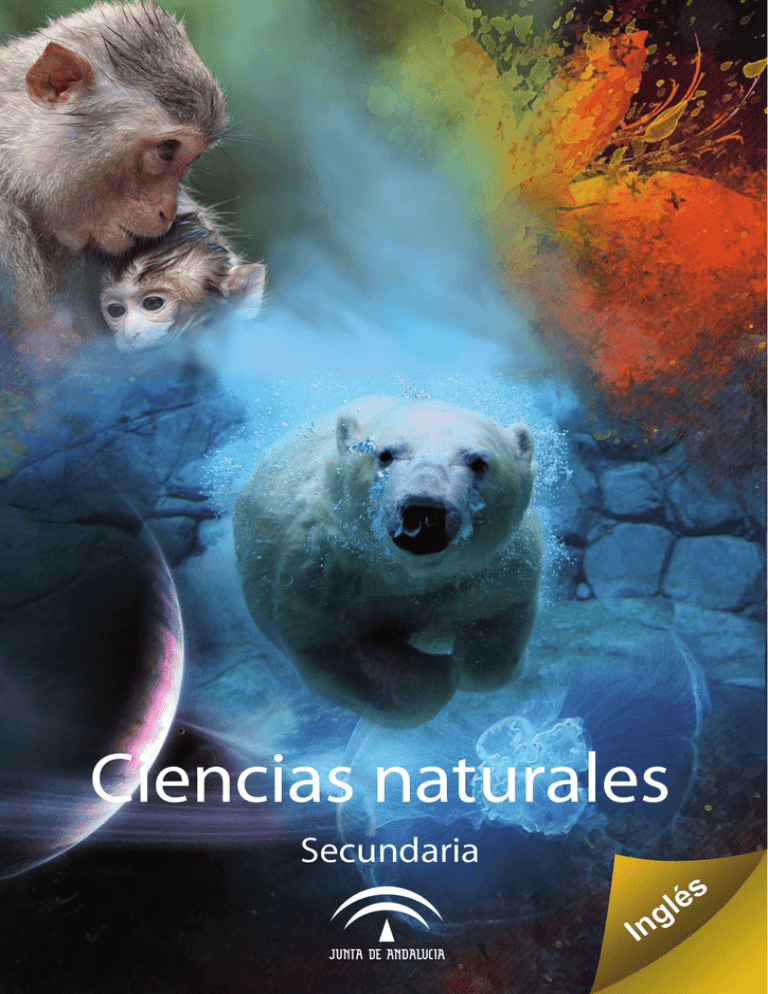
TEACHER´S KEY A.1. La relación de variables en cada experimento son: Experimento 1: Control Variable: Angle + Length Independent Variable: Ammount of mass Dependent Variable: Period. Experimento 2: Controlled Variable: Mass + Length Independent Variable: Angle Dependent Variable: Period. Experimento 3: Controlled Variable: Angle + Mass Independent Variable: Length Dependent Variable: Period. Conclusión del experimento: Period changes when length changes: If length is bigger then the period is bigger too. A.2. Algunas hipótesis que pueden aparecer son: The amount of sugar dissolved depends on on the temperature The amount of sugar dissolved depends on on the type of solvent. Para la hipótesis 1: Controlled Variable: Solvent + amount of solvent (eg. water) Independent Variable: Temperature Dependent Variable: Amount of sugar dissolved Para la hipótesis 2: Controlled Variable: amount of solvent + Temperature Independent Variable: Type of solvent (olive oil, water, pharmacy alcohol) Dependent Variable: Amount of sugar dissolved. A.3. Actividad de búsqueda de información (competencia digital). Las informaciones encontradas serán orientadas a la estructura de las proteínas de la yema (yolk) y la clara (white) del huevo, sobre todo en lo referido a la parte Hidrofóbica e hidrofílica de dichas proteinas. Material AICLE 3º de ESO: How Science Works (Solucionario) 3 Después de estas informaciones las hipótesis deben ir en torno a esto y por ello las hipótesis pueden ser: The proteins of the egg allow a web of molecules, and the size of this web depends on how you beat the eggs or how you heat them. Por tanto los experimentos propuestos deben controlar las variables: Temperature. How fast you beat the eggs (time you are beating eggs) A.4. a) 4 Material AICLE 3º de ESO: How Science Works (Solucionario) A.4. b) Este es el texto completo, señalándose en rojo las palabras perdidas en la actividad. The mercury in tuna Eating fish can be good for you: It builds the brains of babies and helps the hearts of grown-ups. And eating fish can be bad for you: Fish from around the world swim in waters polluted with mercury, which gets into some fish, and then into you when you eat it!. Take tuna as an example. In one of the new studies, researchers studied 100 samples of sushi tuna purchased from grocery stores and restaurants. Sushi is a Japanese dish, usually involving fish that is served raw. The researchers studied the genetic material in the cells of the tuna. They discovered that the tuna came from three types: bigeye, bluefin and yellowfin species. As the scientists expected, the bigger fish contained more mercury. But the scientists were surprised to discover that restaurant tuna contained more mercury than fish from the fishmongers. Worse, yet, restaurant tuna had, on average, more mercury than the maximum amount recommended. The official recommendation is that fish should not contain more than 0.5 parts per million of mercury. The tuna from restaurants had 0.75 parts per million, on average, and some restaurant samples had levels as high as 1 to 2 parts per million. As a result of their study, researches recommend that people, especially pregnant women and young children, should avoid certain types of fish. Mercury is neurotoxic, which means it can injure developing brains. In another study, scientists looked at three kinds of canned tuna: solid-white, chunk-white and chunk-light. On average, light tuna had 0.28 parts per million, which is safely below the health agencies recommendation. But solid and chunk-white types averaged 0.5 parts per million, right at the level of concern. The researchers calculated that a 25-kilogrames child can safely eat only one serving every two weeks. In a third study, researchers studied a database that documents mercury contamination in 51 different types of fish and found that some types have 100 times the amount of mercury typically found in other types. Scientists produced a chart to make it easy for consumers to check the mercury content of the fish they’re about to eat or buy. Material AICLE 3º de ESO: How Science Works (Solucionario) 5 Guide to mercury levels in different varieties of fish and shellfish LOW-MERCURY FISH AND SHEHLFISH VERY LOW BELOW AVERAGE Shrimp (Camarón) Sardines (Sardinas) Tilapia (mojarra) Oysters &Mussels(ostras y mejillones) Clams (almeja) Scallops (vieira) Salmon (Salmón) Crayfish (cangrejo de río) Freshwater Trout (Trucha) Ocean Perch & Mullet (Perca y salmonete) Pollock (pez Carbonero) Atlantic Mackerel (caballa) Anchovies & Herring (Anchoas y arenques) Sole &Plaice(lenguado y Platija) Crabs (cangrejo) Pike (Lucio) Butterfish Catfish (siluro) Squid (Calamar) Atlantic Croaker (Corvina) Whitefish (Pescado Blanco) MODERATE-MERCURY FISH AND SHELLFISH ABOVE AVERAGE MODERATE HIGH Pacific Mackerel (chub) (Caballa) Atlantic Tilefish (Lubina) Cod (bacalao) Caned Light Tuna (Atún en lata) Spiny Lobster (langosta) Snapper, Porgy, Sheepshead (Corvina, Dorada, Sargo) Skate (Raya) Fresh water Perch (perca de agua dulce) Haddock, Hake, Monkfish (abadejo, Merluza, rape) 6 Material AICLE 3º de ESO: How Carp &Buffalofish(Carpa y pez bufalo) Halibut (halibut) Sea trout (trucha de mar) Sablefish (Bacalao Negro) Lingcod & Scorpionfish (especies de bacalao) Sea Bass (lubina) Pacific Croaker (Corvina) American Lobster (Langosta americana) Freshwater Bass (perca) Bluefish (Pescado Azul) Science Works (Solucionario) HIGH-MERCURY FISH HIGH VERY HIGH Canned Albacore Tuna Spanish Mackerel (Caballa Española) Fresh/Frozen Tuna Orange Roughy (perca de aguas profundas) Grouper (Mero) Marlin (Pez aguja) King Mackerel (Caballa rey) Swordfish (Pez Espada) Shark (Tiburón) Gulf Tilefish (Blanquilla del golfo) Tuna Sushi/Bluefin Tuna Some answers to the Questions: 1.- Fish is swing in water polluted with mercury, so mercury gets into you when you has fish. 2.- 100 samples. The bigger fish have more mercury 0.75 parts per million 3.- Tuna in restaurants has more mercury, The results in the chart. The scientific Method Se presentan a continuación tablas con contenidos básicos de cada pieza del “Jigsaw”: 1.- OBSERVATION + QUESTION. What Makes a Good Scientific Question? You have a good scientific question if: • You can find sources of information on the theme? • You can measure changes in the important variables using quantities such as percentage, length, width, weight, energy, time, etc.? • You can change only one variable at a time, and control other variables that might influence your experiment? • You can classify the variables and results. Classify = to arrange in classes according to a criterion or criteria. Material AICLE 3º de ESO: How Science Works (Solucionario) 7 2.-BACKGROUND RESEARCH: You must use library and Internet research to help you find the best way to do things and make sure that you don’t repeat mistakes from the past. A good way is: Identify the keywords in the question. Use a table with the “question words” (why, how, who, what, when, where) to generate research questions from your keywords. For example: 8 Key Word Examples; Why Why does ________ ________? How How does ________ happen? How do we use _________? Who Who needs ________? Who discovered ________? Who invented ________? What What causes ________ to increase (or decrease)? What are the properties of ________? What is the relationship between _______ and ________? When When was _______ discovered or invented? Where Where does ________ occur? Where do we use ________? Material AICLE 3º de ESO: How Science Works (Solucionario) • Finding information When you find information, evaluate if it is good information: Does it come from a credible source? Is it too old? Is it biased? Is it free of errors? Is it properly cited the original source of all information? Is it easy for other people to find or obtain? • On the internet you can find information using Google or another search engine. 3.- HYPOTHESIS Remember: The variables can be Independent, dependent and control. You will have good hypothesis if: It is based on information contained in the Research Background It includes the independent and dependent variables It can be tested in a experiment 4.- EXPERIMENT: You will have a good experimental procedure if: • It is included a description and size for all experimental and control groups • It is included a step-by-step list of all procedures • You have described how to the change independent variable and how to measure that change • You have explained how to measure the resulting change in the dependent variable or variables • You have explained how the controlled variables will be maintained at a constant value You will have a good material if: • You have listed all necessary materials. • You have described the materials in sufficient detail. Material AICLE 3º de ESO: How Science Works (Solucionario) 9 You will have a good Science experiment if: • You take detailed notes about your observations and record them in your laboratory notebook. • You collect your data using a data table• You are consistent, careful, and accurate when you made your measurements. 5 ANALYSE AND REPORT RESULTS: Data analysis and graphs You will have a good chart for a data analysis if: • There is sufficient data to know whether your hypothesis is correct • Your data is accurate. • Your data is summarized with an average • Your chart specifies units of measurement for all data • You have verified that all calculations are correct You will have a Good Graph if: • You select the appropriate graph type for the data you are displaying • Your graph has a title • You place the independent variable on the x-axis and the dependent variable on the y-axis • You label the axes correctly and specifies the units of measurement • Your graph has the proper scale • Your data is plotted correctly and clearly Conclusions and reports You will have good conclusions and reports if: • You summarize your results and use it to support the findings 10 Material AICLE 3º de ESO: How Science Works (Solucionario) • Your conclusions state that you proved or disproved your hypothesis • You state the relationship between the independent and dependent variable • You summarize and evaluate your experimental procedure, making comments about its success and effectiveness • You suggest changes in the experimental procedure and/or possibilities for further study A.5. Scientific method-review. 1. a. False. The scientific method is a logical way of solving problems b. False. In a classification the criteria is the fundamental thing, in fact if you haven’t any criterion you can’t do a classification. c. False. A hypothesis is a statement that you can test with an experiment depending on the variables. d. False. The independent variable must be represented on x-axis and the dependent one in the y-axis. e. False. You must repeat the same experiment three times at least. The final measurements are the average of different trials measurements. 2. The graph on the left i a BAD GRAPH because: • There’s no title. • There are no labels on the x or y axis. • There are no units on the x or y axis. • The dots are connected. The graph on the right is a GOOD GRAPH because it has all the necessary information about the experiment. 3.Dependent Variable Independent Variable Controlled Variable The dependent, variable, is the factor that may change as a result of changes made in the independent variable It is the one that is changed by the scientist As the scientist changes the independent variable, he or she observes what happens. It is the one that serves as the standard of comparison. This variable must not change during the experiment. Material AICLE 3º de ESO: How Science Works (Solucionario) 11 4.- Free responses. SUM-UP 1. Una propuesta para este C-MAP puede ser: A.6. Quantities Number 72 27 89 28 47 100 157 33 500 12 Units How many? 2 3 2 2 1 1 2 1 1 Material AICLE 3º de ESO: How Symbol How many? Km/h g Kg m/s h ºC cm min L cL mg mL 1 2 1 1 1 1 2 1 1 1 1 1 Science Works (Solucionario) A.6 b. El texto completo es el siguiente. Se marca en rojo las palabras de los huecos: An example of a sensor with BAD accuracy and BAD precision: Suppose a lab refrigerator holds a constant temperature of 38.0 ºC. A temperature sensor is tested 10 times in the refrigerator. The temperatures from the test yield the temperatures of: 39.4, 38.1, 39.3, 37.5, 38.3, 39.1, 37.1, 37.8, 38.8, 39.0. This distribution shows no tendency toward a particular value (lack of precision) and does not acceptably match the actual temperature (lack of accuracy). An example of a sensor with GOOD accuracy and BAD precision: Suppose a lab refrigerator holds a constant temperature of 38.0 ºC. A temperature sensor is tested 10 times in the refrigerator. The temperatures from the test yield the temperatures of: 37.8, 38.3, 38.1, 38.0, 37.6, 38.2, 38.0, 38.0, 37.4, 38.3. This distribution shows no impressive tendency toward a particular value (lack of precision) but each value does come close to the actual temperature (high accuracy). An example of a sensor with BAD accuracy and GOOD precision: Suppose a lab refrigerator holds a constant temperature of 38.0 ºC. A temperature sensor is tested 10 times in the refrigerator. The temperatures from the test yield the temperatures of : 39.2, 39.3, 39.1, 39.0, 39.1, 39.3, 39.2, 39.1, 39.2, 39.2. This distribution does show a tendency toward a particular value (high precision) but every measurement is well off from the actual temperature (low accuracy). An example of a sensor with GOOD accuracy and GOOD precision: Suppose a lab refrigerator holds a constant temperature of 38.0 ºC. A temperature sensor is tested 10 times in the refrigerator. The temperatures from the test yield the temperatures of: 38.0, 38.0, 37.8, 38.1, 38.0, 37.9, 38.0, 38.2, 38.0, 37.9. This distribution does show a tendency toward a particular value (high precision) and is very near to the actual temperature each time (high accuracy) The goal of any instrument is to have high accuracy (sensor matching reality as close as possible) and to have a high precision (being able to consistently replicate results and to measure with as many significant digits as appropriately possible). Instruments need to be calibrated in order that they sustain high accuracy and high precision. Material AICLE 3º de ESO: How Science Works (Solucionario) 13
